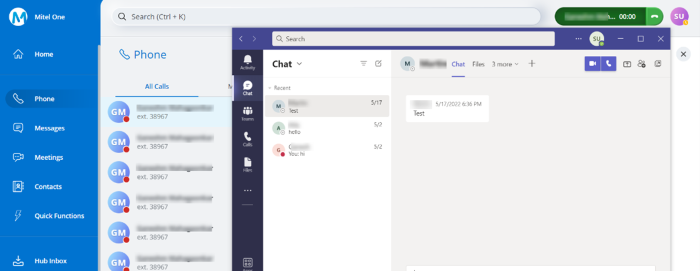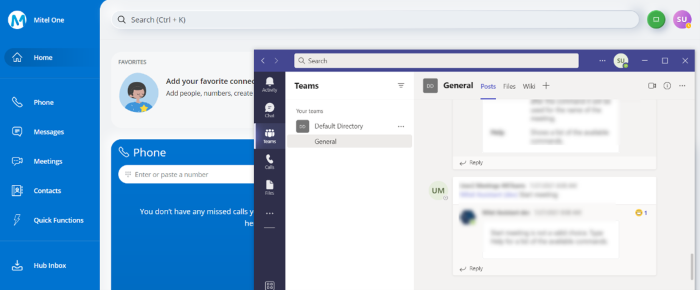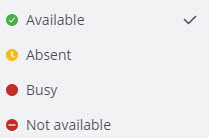Sync Presence via CloudLink to Microsoft Teams
Mitel provides the CloudLink-to-Teams Presence Integration feature, which enables users to know the availability status of the users in the CloudLink account as part of their MS Teams presence.
Configuring a CloudLink Gateway Integration with the PBX (see the Configuring CloudLink Gateway Integrations section in this document.)
Integrating MS Teams with CloudLink (see the CloudLink Integrations to Microsoft Azure AD - Microsoft Teams section in this document)
CloudLink presence is a combination of PBX line state presence and PBX user presence. After the presence sync is enabled for users, the presence status displayed in MS Teams will be a combination of users' presence from the MS Teams clients and CloudLink presence.
PBX user presence is applicable only to MiVoice 400. MiCollab shows PBX line state presence but does not show PBX user presence.
For more information about Configuring Telephony, see the Mitel MS Teams Solution Setup and Features section in this document.
- The Azure Administrator of your organization must register and configure an application in the Azure app registration portal before presence sync can be enabled for an account. After configuring the application in the Azure portal, the Account Administrator must integrate CloudLink with MS Teams in Account Console. For information about MS Teams integration with CloudLink, see Integrating Third-Party Applications with CloudLink Accounts.
- While enabling CloudLink-to-Teams Presence Integration for an account, the Account Administrator must ensure that the CloudLink email IDs of the users in the account match their User Principal Name or Email ID in Azure AD for the feature to work.
MS Teams and CloudLink combine presence sessions differently. In MS Teams, a user can have multiple presence sessions because the user can be on multiple Teams clients (desktop, mobile, and web). Each Teams client has an independent presence session and the user's presence is a combined state from all the sessions.
In CloudLink, a user can have multiple presence states because the user can have multiple devices/lines attached to the PBX. It might be the user presence set in the PBX or Mitel One application. Similarly, for MS Teams, CloudLink combines presence from all the PBX devices/line states and from the user.
- User-configured
> app-configured
The user-configured state overrides others.
- Among app-configured: Do not disturb > Busy > Available > Away.
- Away > Do not disturb > Busy > Available > Offline > Unknown
CloudLink presence state is synchronized with MS Teams as an app-configured presence state by creating an application presence session. MS Teams treats this presence in the same way as it treats the presence from the MS Teams client applications.
For more information about the presence states in MS Teams, see the Microsoft documentation User presence in Teams.
CloudLink Presence |
MIVO400 User Presence State |
|---|---|
Available |
Available |
Away |
Absent |
Busy |
Busy or Meeting |
Not available |
Not available |
Users will appear as Busy in MS Teams when they are Busy on their phones unless they have configured Away. When you initiate a call while you are in the Away state in the Mitel One application, your status will not change to Busy; as Away has higher precedence than Busy in the Mitel One application. The following screenshot illustrates the above-mentioned scenario with Mitel One running on MiVoice Office 400.

In Teams when the presence status of the user is Available, and the user's state is Away in the Mitel One application, the Away state will not be displayed in Teams because Away has lower precedence than Available in Teams. When you log out from all the Teams clients, then your state will be displayed as Away for other users in Teams because Away has higher precedence than Offline in Teams. The following screenshot illustrates the above-mentioned scenario with Mitel One running on MiVoice Office 400.

Setting Presence in MiCollab/Mitel One or MiVoice Office 400 PBX
If you explicitly set your presence status in the MiCollab client, this is not synchronized with MS Teams.
If you explicitly set your presence in the Mitel One client or in the MiVoice Office 400 PBX (for example, from the desk phone), the presence status is synchronized with MS Teams. However, there are limitations which might cause unexpected behavior, as shown in the following table.
| PBX Phone Presence | PBX User Presence | Mitel One Presence | MS Teams Client State | MS Teams Presence Status (What others see) |
|---|---|---|---|---|
| Available | Available | Available | Offline | Offline |
| Available | Available | Available | Connected, Inactive | Away |
| Available | Available | Available | Connected, Active | Available |
| Available | Available | Available | Busy (in Teams call/meeting) | Busy |
| Available | Available | Available | Focus/Presenting | Do not disturb |
| Busy | Available | Busy | Offline | Busy |
| Busy | Available | Busy | Connected, Inactive | Busy |
| Busy | Available | Busy | Connected, Active | Busy |
| Busy | Available | Busy | Busy (in Teams call/meeting) | Busy |
| Busy | Available | Busy | Focus/Presenting | Do not disturb |
| Available | Busy | Busy | Offline | Busy |
| Available | Busy | Busy | Connected, Inactive | Busy |
| Available | Busy | Busy | Connected, Active | Busy |
| Available | Busy | Busy | Busy (in Teams call/meeting) | Busy |
| Available | Busy | Busy | Focus/Presenting | Do not disturb |
The following definitions apply for the table above:
PBX Phone Presence Status - When you place a call or answer a call using your desk phone, your presence status will be Busy, otherwise it will be Available.
PBX User Presence Status - Your presence status can be managed via the system menu in the Mitel 69xx phone or by assigning a key. You can look up the presence of other users in a directory lookup or in a call list, on the desk phone.
You can also manage your presence status using the self-service portal.
- Available (default)
- Absent
- Meeting
- Busy
- Not Available
Mitel One Presence Status - You can also manage your presence from the Mitel One application using the following menu:

These presence statuses in Mitel One are synchronized with your presence in the MiVO400 PBX as follows:
| Mitel One Presence Status | MiVoice Office 400 Presence Status |
|---|---|
| Available | Available |
| Away | Absent |
| Busy | Busy or Meeting |
| Not available | Not available |
MS Teams Client Presence Status
Your presence in MS Teams depends on your MS Teams client applications (desktop, mobile and web) and connected applications such as MS Outlook or MS PowerPoint.
Each Teams client has an independent presence session, and your presence in MS Teams is a combined state from all the sessions. Similarly, connected applications such as Outlook have their own combined presence session.
If your Teams clients are not running and not active, your status is Offline.
If your Teams clients are running but not active (for example screen locked), your status is Away.
If your Teams clients are running and active, your status is Available.
Your Teams client or connected application will send your status as Busy if you are on a Teams audio call, or if you are in a meeting.
Your Teams client or connected application will send your status as Do not disturb if you are presenting or focusing.
The presence status will be shown as Busy, if the user is actively using their PBX phone or it will be shown as Do not disturb, if the user has activated the Do not disturb feature on the PBX.
There are other presence states too, but these are the most common.
-
User-configured > app-configured (user-configured state overrides others)
-
Among app-configured: Do not disturb > Busy > Available > Away